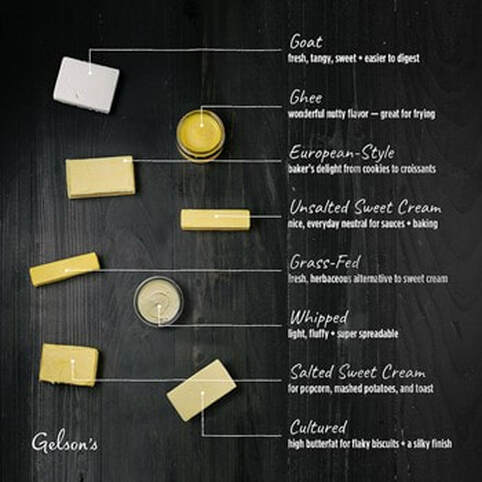The 2020 Holidays Recipe Collection  Guide to Butter courtesy of Gelson's Markets Guide to Butter courtesy of Gelson's Markets How you doin’? Every day I get all sorts of food related emails; most people are asking for a recipe or ingredient sourcing information. But occasionally, I get some interesting information that I want to pass on to you. That’s the case with this Guide to Butter that I received from Gelson’s this morning. Gelson's is an upscale regional supermarket chain operating in Southern California. It operates service-oriented stores mostly in upmarket neighborhoods. The Mayfair Connection began years before Gelson's did. Estimates put the genesis of the chain sometime around 1929. In 1948, Arden Farms Company owned both Mayfair Markets and Van’s Markets. Arden created a new chain of stores: "Mayfair Markets", from the two existing chains. Arden-Mayfair gradually sold off most of the stores, as the market favored supermarket formats that were larger in size. Over time, all the larger, upscale Mayfair stores were renovated to become Gelson's. Gelson’s market is grocery store that my family has been shopping at since they first opened the store in Century City, California. I have a very close connection to Century City, which has nothing to do with butter—but it’s interesting anyway. The land on which Century City sits belonged to cowboy actor Tom Mix, who used it as a ranch. It later became the backlot of 20th Century Fox (now Disney), which still has its headquarters just to the southwest. In 1956, Spyros Skouras, who served as the President of 20th Century Fox and his nephew-in-law Edmond Herrscher, sometimes known as "the father of Century City", decided to repurpose the land for real estate development. The following year, in 1957, they commissioned a master-plan development from Welton Becket Associates, which was unveiled at a major press event on the "western" backlot later that year. As a young boy, I used to ride my bike to Western Street and sneak through the fence to watch them film cowboy movies. I used to dress up in my chaps and strap a holster on my hip and play cowboy with “real” cowboys—Giddyap! I was often invited to have lunch on the set with the cast and crew and even got put on a horse once or twice… didn’t I feel important? In 1961, after Fox suffered a string of expensive flops, culminating with the financial strain put on the studio by the very expensive production of Cleopatra, the film studio sold 180 acres to a developer and Alcoa, for $300 million ($5.4 billion in 2020 dollars). Now that’s a helluva lot of bread & butter. Now, here’s buttttter! If all the fats got together and held a popularity contest, butter would surely win hands down. Butter makes our baked goods tender, moist, and flaky. It pulls the flavors through our savory dishes. Sauces are lush with it and gravies are thick with it. Most importantly, good butter simply tastes wonderful — it gives a purpose to toast. And now is an especially thrilling time to be cooking and baking with butter. There are more butters than ever in our dairy case: Sweet, salty, cultured, European, goat, and ghee, just to name a few. Of course, while all that variety is inspiring, it can also be a little baffling. What’s the difference between all these butters, and what are we supposed to do with them? Here’s a list of all the major butter categories and how to put them to use in your kitchen. The good news, butter lovers and cooks, is that no single butter is perfect for everything, and every butter is special—so you might have to try them all. Sweet Cream Butter — Salted and Unsalted This is the butter most Americans have in their fridges. It’s made with sweet cream—meaning fresh pasteurized milk versus cultured (see below)—and per regulations, must be at least 80% butter fat. In its salted form, it’s great for finishing stuff: melt it and drizzle over popcorn, swirl it through your mashed potatoes—or drop a knob of it on your steak in the last minutes of cooking. If you’re baking or making a sauce, it’s better to use the unsalted variety because it gives you more control over flavor. With its high water content, it’s particularly good for choux pastry or cream puffs! Grass-Fed Butter Made from the milk of cows that feed on grass, this butter has a yellow hue that can vary in richness with the seasons—as the cows move from summer grass to winter hay. It has a fresh, pleasantly herbaceous flavor. Those grassy notes are harder to pick out once the butter is in foods, but if you’re making something like a beurre blanc, you may want to use a butter with a more neutral cream flavor. Is grass-fed butter good for you? It may have higher levels of Omega 3 Fatty Acids than conventional sweet-cream butters, but you’d have to eat an awful lot of butter to match benefits of other sources, like fish, nuts, and seeds. Ghee Ghee is a rendered butter, meaning it’s cooked to remove the water and milk solids—leaving pure, golden butter fat with a wonderful nutty flavor. What’s the difference between ghee and clarified butter? Basically, the cooking processes are very similar, but clarified butter doesn’t brown, so it has a more neutral flavor. Use ghee in your Middle Eastern and Eastern Asian dishes, like dal or curry, or for making butter sauces—like a lemony dip for lobster. It has a very high smoke point, so it’s also great for frying stuff. Bonus: It will keep in an airtight container in the cupboard for one month. European-Style Butter Although different countries and producers may have their own butter recipes, there is a consistent tradition throughout Europe: Butter is slowly churned until it achieves a butterfat content of at least 82 percent. It’s also allowed to ferment. This approach means that it melts faster, and it has a super-rich, lightly tangy flavor and a soft texture. For all those reasons, bakers prefer European-style butter. It makes pies flaky and cakes rise a little higher, and it gives laminated doughs, like croissants, a beautiful airy texture. The high butterfat also means less water, so it’s a good butter for pan searing a steak or a piece of fish. Cultured Butter A cultured butter is made either by allowing the cream to ferment or by adding live bacteria to it before it’s churned, much like yogurt. It often has a very high butterfat content, up around 86% depending on the producer. That gives it a silky mouthfeel and a rich, complex flavor—full of cream and yet slightly sour from the cultures. Again, the high butterfat equals less moisture: This butter will make your biscuits flakier, your cookies crisper, and the crumb of your cake more tender. And, with all those cultures, it may also be easier to digest! Goat Butter Made with milk from goats, this butter has a similar fat content to sweet-cream butter but is otherwise quite different. Goats don’t process their feed the same way cows do, so the butter is white, and it has a distinct flavor—it’s tart, like good yogurt, yet sweet and light. (One of the tasters called it “dessert butter!”) It generally comes salted and it has a low melting point, so it’s nice and soft. Use it like you would salted sweet-cream butter. Goat butter is also a great alternative for people who are allergic to cow’s milk or lactose intolerant: It’s lower in casein and easier to break down and digest than cow’s milk. Whipped Butter Whipped butter has air or nitrogen gas whipped through it, which makes it soft and fluffy. It’s considered healthier because—what with all that air—there’s less fat per tablespoon. (And by law, whipped butter only has to be 25% butterfat.) Whipped butter is too melty and foamy for cooking. Its superpower is spreadability, so it makes a great table butter—it’s not going to shred your toast! Serve it with muffins, baguettes, and sweet breads. ChefSecret: Whipped butter is easy to whip at home using a stand mixer fitted with a whisk attachment. Covid-19 Quip of the Day: “What did the sick parent make their kids for lunch? Mac and sneeze.” ------------------------------------------- Do you have a question or comment? Do you want to share a favorite recipe or pictures with our readers? Send your thoughts to [email protected]. All recipes and cooking tips are posted on our website https://www.perspectives-la.com/covid-19-survival-guide. ------------------------------------------- Here is wishing you the very best for the upcoming holidays. To you and everyone dear to you, be strong, be positive, stay well, stay safe and be kind welcoming in the holiday season. If you have a little extra in your pockets to share with others at this difficult time, please consider donating to Feeding America. Thanks for reading. #Baking #Butter #Ghee #ClarifiedButter #CulturedButter #Gelsons #HolidayRecipes #Holidays2020 #QuarantineKitchen #Covid19 #FeedingAmerica #PerspectivesTheConsultingGroup ©Perspectives/The Consulting Group, Inc., 2020
0 Comments
Your comment will be posted after it is approved.
Leave a Reply. |
For over 4 decades collaboration and vision have been the cornerstones of our approach to developing innovative solutions. We fuel innovation, uncover opportunities, discover trends and embrace sustainability, turning imaginative ideas into profitable realities. Categories
All
Archives
July 2024
|
www.perspectives-la.com
Copyright © 2021 Perspectives/The Consulting Group, LLC | Henderson, NV 89052 | 310-477-8877
Copyright © 2021 Perspectives/The Consulting Group, LLC | Henderson, NV 89052 | 310-477-8877


 RSS Feed
RSS Feed